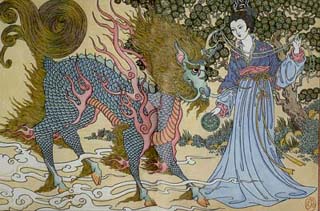 Another form of the unicorn can be found in East-Asia.
In China k'i-lin (with k'i for the male and "lin" for the female part)
was honoured as the king of the land animals. Because of its strenght and
wisdom you could compare it with the Chinese dragon and it was also seen
als representation of compassion and the love of peace. The k'i-lin is
often shown with fish scales that shimmer in every colour of the rainbow.
This unicorn brought important messages to human beeings and it was seen
in 2697 BC for the first time as it wandered through the palace of the
emperor Huang-ti. This was seen as the announcement of lucky years. People
say that in the following years Huang-ti invented music instrumnets, taught
his people how to build houses with bricks and united the Chinese tribes
for the first time. The k'i-lin showed itself to the emperor at the end
of his life for a second time to carry him to the land of the dead on its
back.
Another form of the unicorn can be found in East-Asia.
In China k'i-lin (with k'i for the male and "lin" for the female part)
was honoured as the king of the land animals. Because of its strenght and
wisdom you could compare it with the Chinese dragon and it was also seen
als representation of compassion and the love of peace. The k'i-lin is
often shown with fish scales that shimmer in every colour of the rainbow.
This unicorn brought important messages to human beeings and it was seen
in 2697 BC for the first time as it wandered through the palace of the
emperor Huang-ti. This was seen as the announcement of lucky years. People
say that in the following years Huang-ti invented music instrumnets, taught
his people how to build houses with bricks and united the Chinese tribes
for the first time. The k'i-lin showed itself to the emperor at the end
of his life for a second time to carry him to the land of the dead on its
back.
It is also written that the k'i-lin appeared in the 6th century BC in a temple in front of a young woman called Yen Tschen-Tsai and that it showed her with a jade plate that she would give birth to a "king without throne". Although the woman tried to hold the unicorn with a rope of silk the k'i-lin simply bowed and vanished again. The son that was later born by that woman, Konfuzius, created some years later with his teaching that system of order which has influenced the Chinese politics and philosophers for centuries.
 The Japanese unicorn is called Kirin. It was said
to have a never-failing sense of justice which sometimes made it appear
at court killing the guilty and freeing the innocent.
The Japanese unicorn is called Kirin. It was said
to have a never-failing sense of justice which sometimes made it appear
at court killing the guilty and freeing the innocent.
